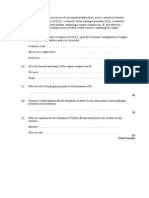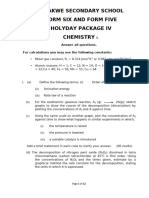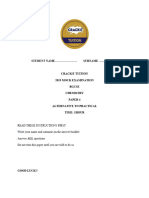Module 2
Uploaded by
chavezallen1995Module 2
Uploaded by
chavezallen1995MODULE 2 6. (a) The temperature at which the reaction between chlorine and aqueous sodium h dro!
ide occurs determines the products o" the reaction. E!plain this phenomenon# usin$ equations to illustrate our answer. % & mar's( (b) Use the redo! potential )alues $i)en to e!plain the similarities and di""erences in the beha)iour o" the halo$ens with the thiosulphate (*2O+2,) ion. -l2(aq) . 2e // 3r2(aq) . 2e ) 4 82(aq) . 2e ) ! 2 *O+2, . +;2O . :e, *:O62, . 2e [ > mar's( (c) Describe how sil)er nitrate solution can be used to distin$uish amon$ the halides -l,# 3r < and 8A . %+ mar's( 2-0, (aq) 23r (aq) 28,(aq) *2O+2< . 6 O;= 2 *2O+2< Ee 1 .0.+62 E5 1.0.672 Ee 1 . 6.9:2 E/ 1 . 6.9> V E?@ 1 . 6.6& V
Total 20 marks (a) Bro)ide e!planations "or EC-; o" the "ollowin$ in terms o" the characteristic properties o" transition metals and their comple!esD (i) Cnh drous copper (88) sulphate is a white solid that $raduall turns blue on the dropwise addition o" water. Eurther addition results in the solid dissol)in$ with the "ormation o" a blue solution. % : mar's( The $radual addition o" a concentrated solution o" sodium chloride to aqueous copper (88) sulphate leads to the "ormation o" a $reen solution. C colour chan$e "rom $reen to ellow is obser)ed on "urther addition o" the sodium chloride solution. % + mar's(
(ii)
The comple! ion X is obtained on addin$ a concentrated solution o" 4a-4 to aqueous 4i-l . The ion X has the percenta$e composition o" +6.0 F 4i# 2&.9 F - and +:.: F 4. Determine the "ormula o" the comple! ion X. %: mar's( Draw the shape o" the comple! ion X. %0 mar' ( (c) Cccount "or EC-; o" the "ollowin$ statementsD %Use Ee )alues pro)ided in the Data 3oo'let where appropriate( (i) ;aemo$lobin has a comple! unit that a""ords the transportation o" o! $en to the tissues. ;owe)er# the carr in$ capacit o" haemo$lobin is reduced in the presence o" carbon mono!ide. (ii) [ : marks] (ii) The man$anate (288) ions (MnO:,) and dichromate (28) ions (-r2O72,) are power"ul o!idiGin$ a$ents. [ 4 marks] Total 20 marks
(b)
You might also like
- 9204 Question Paper International Gcse Combined Science Chemistry Ext Nov21 PDFNo ratings yet9204 Question Paper International Gcse Combined Science Chemistry Ext Nov21 PDF36 pages
- Acids and Bases - HL - 002: (153 Marks)No ratings yetAcids and Bases - HL - 002: (153 Marks)36 pages
- 962/2 2006 Trial Examinations Upper 6 Panitia Daerah Johor Bahru Chemistry Paper 2 (2 Hours)No ratings yet962/2 2006 Trial Examinations Upper 6 Panitia Daerah Johor Bahru Chemistry Paper 2 (2 Hours)12 pages
- Plkvktcsfc_f6_2019-2020_chem Pp2 - Kuok KellyNo ratings yetPlkvktcsfc_f6_2019-2020_chem Pp2 - Kuok Kelly8 pages
- Chemistry 2 - Exam n Answers - Msomibora.com(3)No ratings yetChemistry 2 - Exam n Answers - Msomibora.com(3)15 pages
- © Ncert Not To Be Republished: Model Question Paper-IiNo ratings yet© Ncert Not To Be Republished: Model Question Paper-Ii11 pages
- IAL Chemistry Unit-02 Samplepaper - 03 PDFNo ratings yetIAL Chemistry Unit-02 Samplepaper - 03 PDF17 pages
- AL - Chemistry Paper II by Dr. Sally WongNo ratings yetAL - Chemistry Paper II by Dr. Sally Wong19 pages
- Metallabenzenes: An Expert ViewFrom EverandMetallabenzenes: An Expert ViewL. James WrightNo ratings yet
- Gas Hydrates 1: Fundamentals, Characterization and ModelingFrom EverandGas Hydrates 1: Fundamentals, Characterization and ModelingDaniel BrosetaNo ratings yet
- Nucleation and Crystal Growth: Metastability of Solutions and MeltsFrom EverandNucleation and Crystal Growth: Metastability of Solutions and MeltsNo ratings yet
- CAPE NOTES Unit 2 Module 1 Database Management-1No ratings yetCAPE NOTES Unit 2 Module 1 Database Management-115 pages

































































